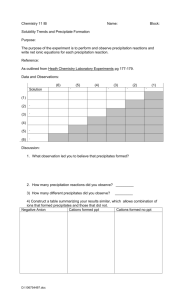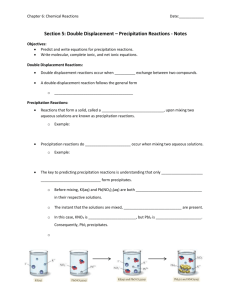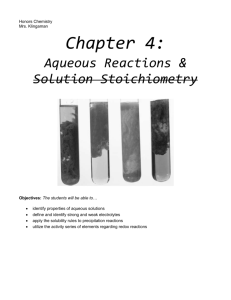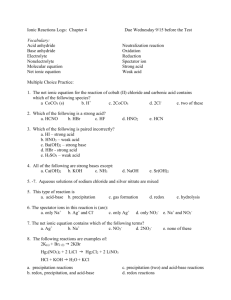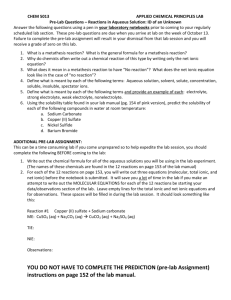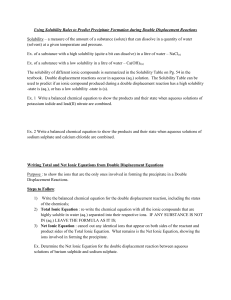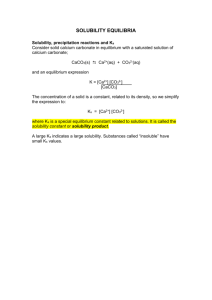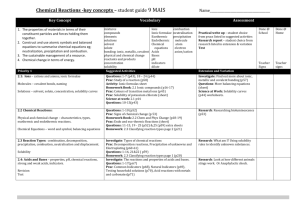Precipitation Reaction (lab exercise)
advertisement
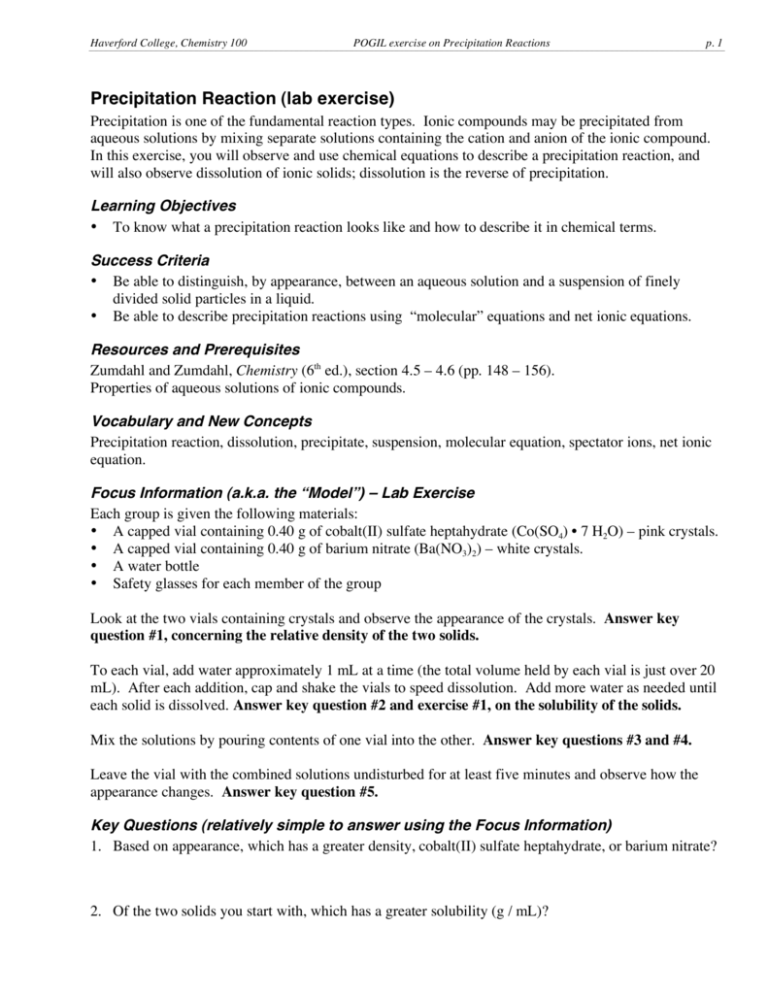
Haverford College, Chemistry 100 POGIL exercise on Precipitation Reactions p. 1 Precipitation Reaction (lab exercise) Precipitation is one of the fundamental reaction types. Ionic compounds may be precipitated from aqueous solutions by mixing separate solutions containing the cation and anion of the ionic compound. In this exercise, you will observe and use chemical equations to describe a precipitation reaction, and will also observe dissolution of ionic solids; dissolution is the reverse of precipitation. Learning Objectives • To know what a precipitation reaction looks like and how to describe it in chemical terms. Success Criteria • Be able to distinguish, by appearance, between an aqueous solution and a suspension of finely divided solid particles in a liquid. • Be able to describe precipitation reactions using “molecular” equations and net ionic equations. Resources and Prerequisites Zumdahl and Zumdahl, Chemistry (6th ed.), section 4.5 – 4.6 (pp. 148 – 156). Properties of aqueous solutions of ionic compounds. Vocabulary and New Concepts Precipitation reaction, dissolution, precipitate, suspension, molecular equation, spectator ions, net ionic equation. Focus Information (a.k.a. the “Model”) – Lab Exercise Each group is given the following materials: • A capped vial containing 0.40 g of cobalt(II) sulfate heptahydrate (Co(SO4) • 7 H2O) – pink crystals. • A capped vial containing 0.40 g of barium nitrate (Ba(NO3)2) – white crystals. • A water bottle • Safety glasses for each member of the group Look at the two vials containing crystals and observe the appearance of the crystals. Answer key question #1, concerning the relative density of the two solids. To each vial, add water approximately 1 mL at a time (the total volume held by each vial is just over 20 mL). After each addition, cap and shake the vials to speed dissolution. Add more water as needed until each solid is dissolved. Answer key question #2 and exercise #1, on the solubility of the solids. Mix the solutions by pouring contents of one vial into the other. Answer key questions #3 and #4. Leave the vial with the combined solutions undisturbed for at least five minutes and observe how the appearance changes. Answer key question #5. Key Questions (relatively simple to answer using the Focus Information) 1. Based on appearance, which has a greater density, cobalt(II) sulfate heptahydrate, or barium nitrate? 2. Of the two solids you start with, which has a greater solubility (g / mL)? Haverford College, Chemistry 100 POGIL exercise on Precipitation Reactions p. 2 3. What did you observe when you mixed the two solutions? 4. What are balanced chemical equations for the reaction that occurred? Solubility rules such as found in your textbook are useful in identifying the product. a. In a “molecular” equation, the two reactants are written as Co(SO4) (aq) and Ba(NO3)2(aq) (i.e., as if cobalt sulfate and barium nitrate consisted of neutral molecules, which they don’t). b. In a net ionic equation, the dissolved ionic compounds are written as separate ions, and “spectator ions” (those that stay in solution without reacting) are eliminated from the equation. 5. Based on where the pink color started and where it ends up, which of the four ions involved in this reaction (barium(2+), cobalt(2+), sulfate(2-) or nitrate (-) is colored pink? Explain. Exercises (may require a bit more thought and strategy than the Key Questions) 1. Molar solubility has units of mol / L. Estimate the volume of water required to dissolve the 0.40 g of each solid, and then estimate the molar solubility of each compound. Even a one significant figure calculation is informative. (1 mol / L is soluble; 1 mmol / L is slightly soluble; 1 µmol / L is insoluble). Are you able to say with confidence which starting solid has the greater molar solubility? 2. Categorize each of the following adjectives as to whether they apply to ALL, SOME, or NO aqueous solutions, or to ALL, SOME or NO suspensions of tiny solid particles in a liquid. Fill in ALL, clear SOME or NO Aqueous Solution Suspension of solid in liquid lumpy transparent colorless opaque cloudy homo- hetero- white geneous geneous 3. Assume that the reaction you wrote in key question 4 went to completion. Calculate how many grams of the solid product settled to the bottom. Which ions remained in the solution over the solid?
